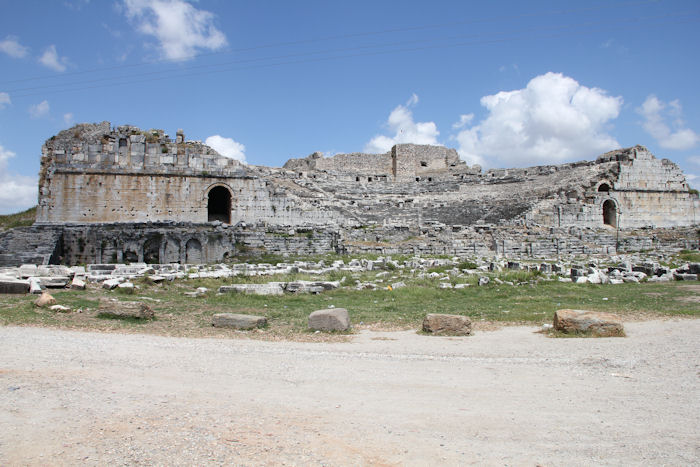MILETUS
|
Miletus was first occupied in 1400 BC by Minoans from Crete, then Mycenaeans from the Peloponnese, then by refugees from Greece during the Dorian invasion. It prospered and grew wealthy from its colonies on the Mediterranean, the Black Sea and Egypt. Miletus became the most important of the 12 cities of Ionia, and was one of the first cities in the ancient world to mint coins. It was mentioned by Homer in The Iliad. About 499 BC the Milesians led the Ionian revolt that sparked the Greco-Persian Wars and Miletus was stormed and sacked by the Persians, allowing Ephesus to become the most important city in the region. But Miletus was rebuilt, and its streets were laid out according to the plan of Hippodamus, native of Miletus and inventor of the "Hippodamian grid". After the Greeks defeated the Persians in 479, Miletus joined the Athenian-dominated Delian League, but in 412 BC Miletus sided with Sparta against Athens. Ffamous citizens of ancient Miletus included Thales, Anaximander and Anaximenes, all philosophers of nature and the universe; the historian and geographer Hekataios, who first used the word "history" in its modern sense; and Isidorus, one of the designers of the Hagia Sophia. Perhaps greatest contribution of Miletus to Greek civilisation was the Ionian alphabet which was adopted by Athens in 703 - 402 BC and eventually became the standard Greek alphabet. Miletus was weakened by internal divisions when Alexander the Great seized it in a great battle (c.334 BC). After Alexander's death, Miletus was ruled by his general Lysimachus, who made generous donations to the city. The Romans annexed the area in 133 BC and added several monumental structures to the city. The Emperor Trajan (2nd century AD) built the Sacred Way from Miletus to Didyma. According to the Jewish historian Josephus. Miletus had a Christian bishop by the time of Decius, when St. Thyrsus and his companions were martyred at Miletus. Eusebius, Bishop of Miletus, attended the Council of Nicea in 325. After the 3rd century, Miletus began to decline. By the 6th century, the silting of the Meander River had destroyed the city's harbours and attracted malaria. By the Ottoman period, the once-proud city was just a small village and was finally abandoned in the 17th century. Miletus was originally situated on a spit of land, surrounded on three sides by water. It is now 5 miles inland. It is difficult to visualise today, although the low-lying nature of parts of the site causes some flooding. It is difficult to imagine that Miletus was once situated on a peninsula, with three harbors on the west and one on the east. Today, the harbors have silted up to such an extent that the ruins of Miletus are located in a broad plain 5 miles inland.  The theatre has a facade of 460 feeet (140 m) and a present height of 100 feet (30 m) . It was originally built in the 4th century BC, but modified and enlarged under Trajan in the 2nd century AD to seat 25,000 spectators.
The theatre has a facade of 460 feeet (140 m) and a present height of 100 feet (30 m) . It was originally built in the 4th century BC, but modified and enlarged under Trajan in the 2nd century AD to seat 25,000 spectators. Also added in the Roman period was a third floor to the stage building, which was decorated with columns and hunting scenes with Eros. In the centre of the first two rows, four columns designated as a special box for the emperors.
Also added in the Roman period was a third floor to the stage building, which was decorated with columns and hunting scenes with Eros. In the centre of the first two rows, four columns designated as a special box for the emperors. Reconstructed part of the Ionic stoa along east side of the Sacred Way.
Reconstructed part of the Ionic stoa along east side of the Sacred Way. Part of Sacred Way?
Part of Sacred Way?
 The Baths of Faustina, built on the orders of the wife of Marcus Aurelius in 164 AD.
The Baths of Faustina, built on the orders of the wife of Marcus Aurelius in 164 AD. The Baths of Faustina: calidarium (hot room).
The Baths of Faustina: calidarium (hot room). The Baths of Faustina: frigidarium (cold room) featuring statues of the river god Meander and a small lion (below).
The Baths of Faustina: frigidarium (cold room) featuring statues of the river god Meander and a small lion (below). The Baths of Faustina: frigidarium (cold room).
The Baths of Faustina: frigidarium (cold room). The Baths of Faustina: apodyterion (changing rooms).
The Baths of Faustina: apodyterion (changing rooms). |
|
Alinda |
Aphrodisias |
Assos |
||||||
|
Didyma |
Ephesus |
Euromos |
||||||
|
Miletus |
Nysa |
Pergamon |
||||||
|
Priene |
Sardis |
Stratonikeia |
||||||
|
Troy |